More than half of all bird species (5000+) are classified in order Passeriformes and referred to as passerines. Passerines, sometimes known as perching birds or less accurately as songbirds, have four toes – three of them directed forward and one toe directed back.
This arrangement allows for stable perching on structures such as small branches and herbaceous stems because the hind toe is opposable to the others (much like our thumbs are opposable to our fingers) which allows “grasping”.
Interestingly, the tendon/bone anatomy of a passerine causes automatic closing of the foot (grasping) when the leg bends – such as when it lands on a typical perch. This arrangement also allows passerines to sleep on a perch without falling off.
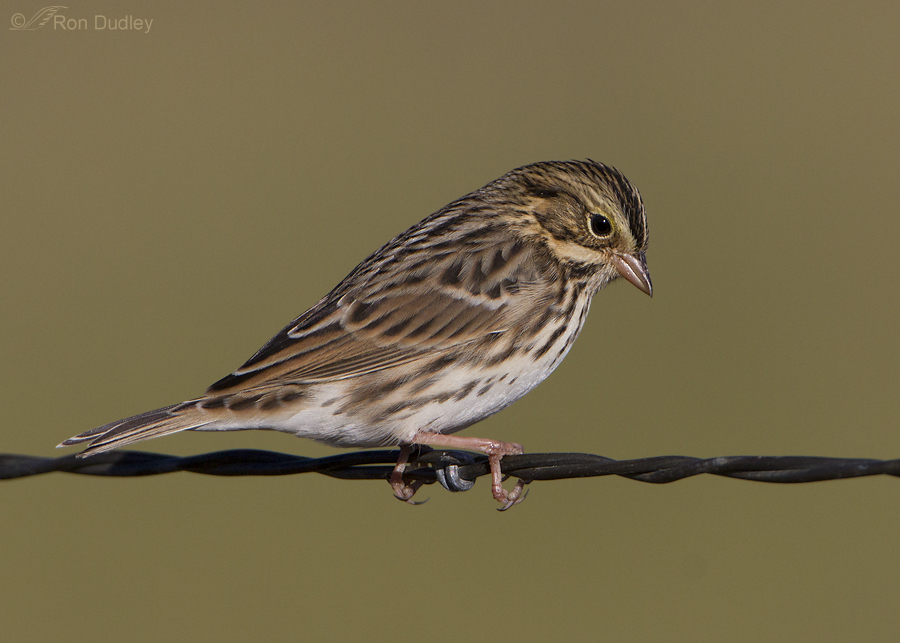
Here you can see the typical “three toe forward, one toe back” arrangement on this Savannah Sparrow that allows passerines to grasp narrow perches like branches or wires and remain stable on them. Animals without something like this toe arrangement would be “walking a tightrope” but these birds have no problem with it.
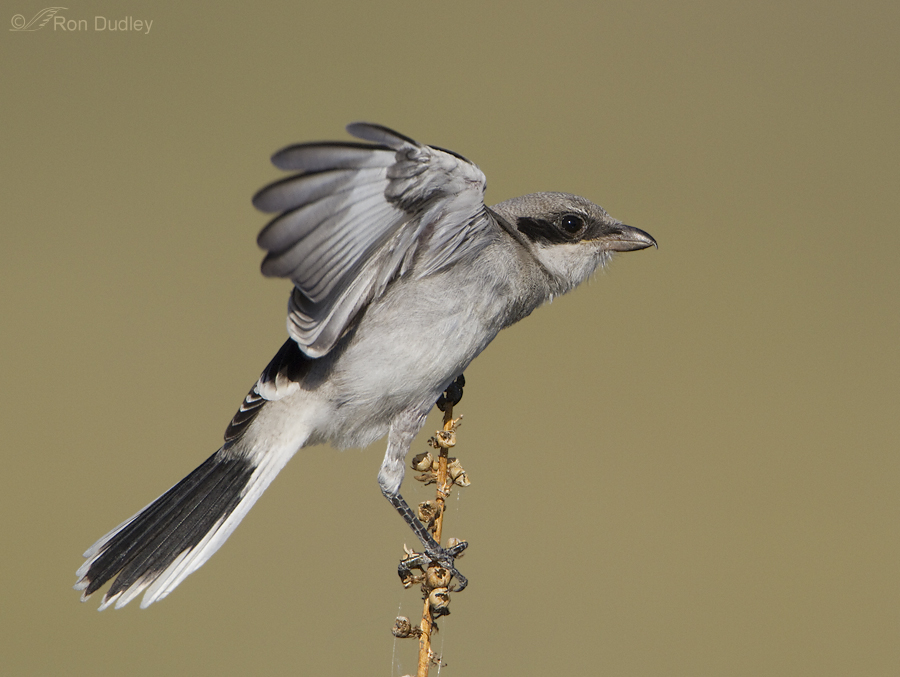
Maintaining stability on a perch such as this would be virtually impossible without the ability to grasp, particularly in a breeze (this is a Loggerhead Shrike).
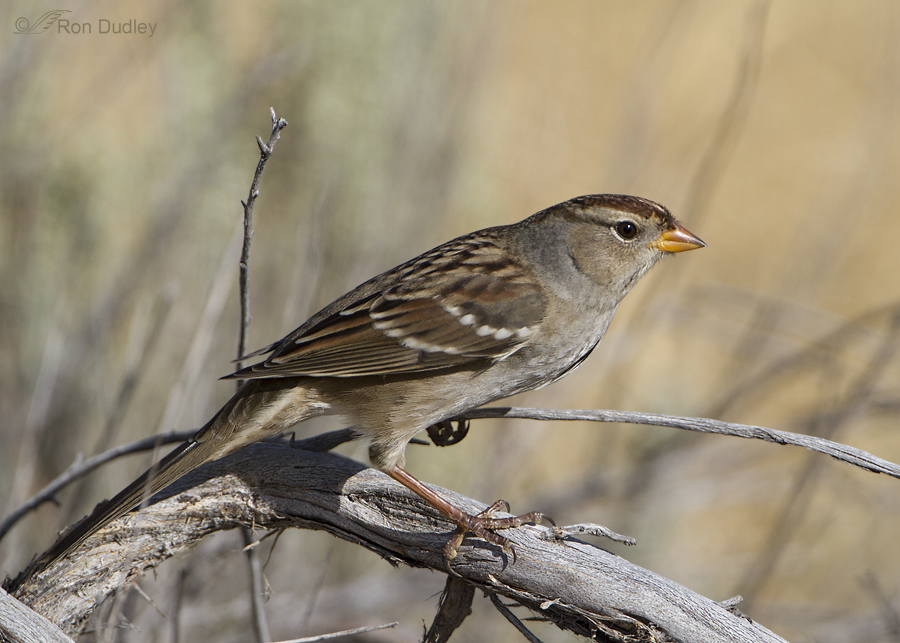
This shot of a juvenile White-crowned Sparrow gives us a better look at all four toes.
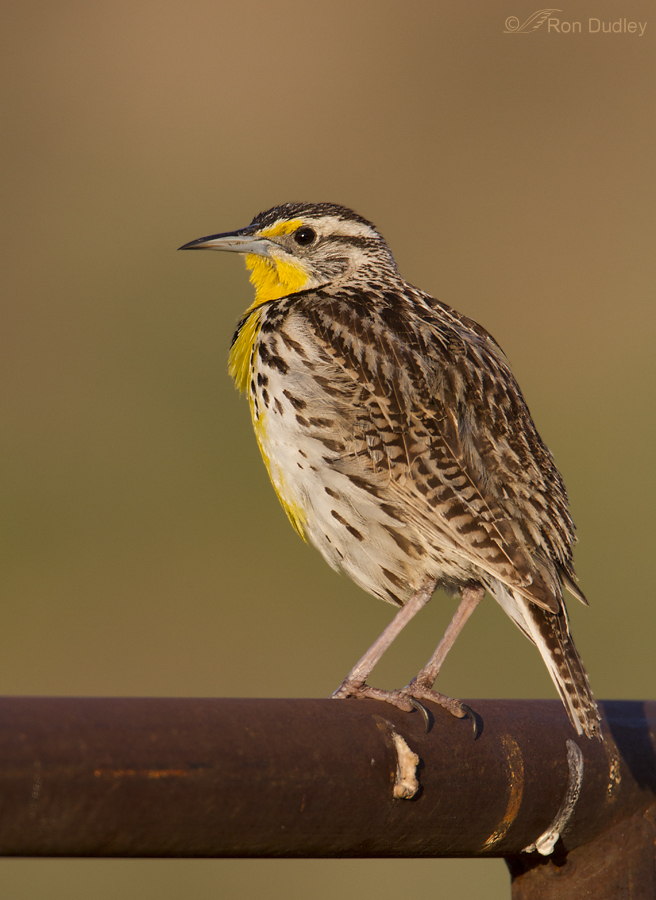
One more look at the opposable rear toe, this time on a Western Meadowlark.
Ok, now to my point. Many birds that do not typically “perch” (with exceptions) are waterfowl and shorebirds. The Killdeer is a plover but because of the habitats it prefers it’s often found with passerines and many of us associate them with the perching birds. But think about it, have you ever seen a Killdeer perched in a tree, on a branch, narrow stem or wire? I don’t think I have and I’ve spent a lot of time over the years with them.
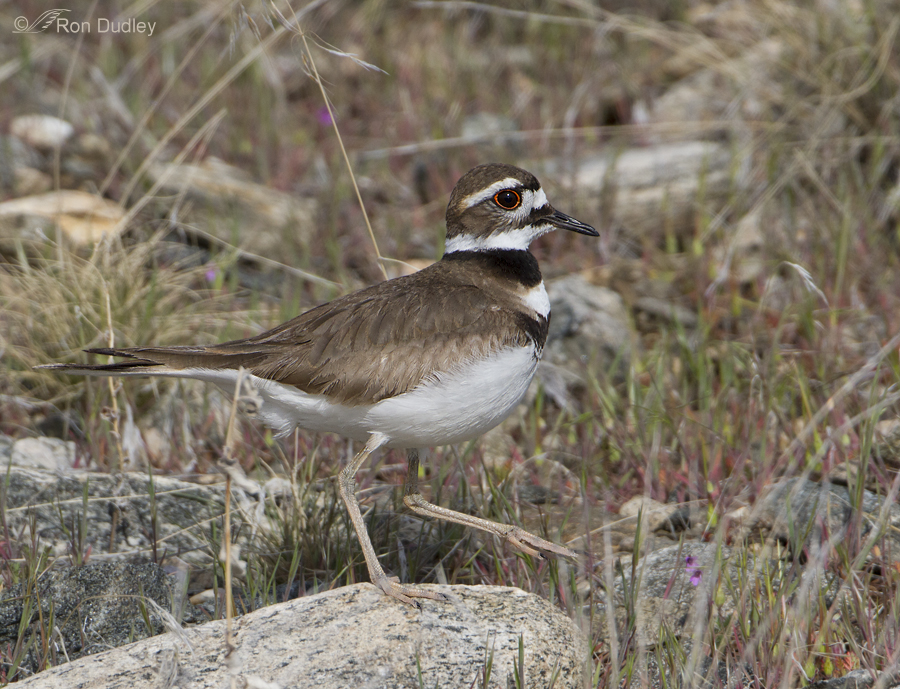
And here’s why. Like most plovers, Killdeer lack the hind toe so they rarely perch (except on something like a rock). They do not have the ability to grasp a narrow perch for stability.
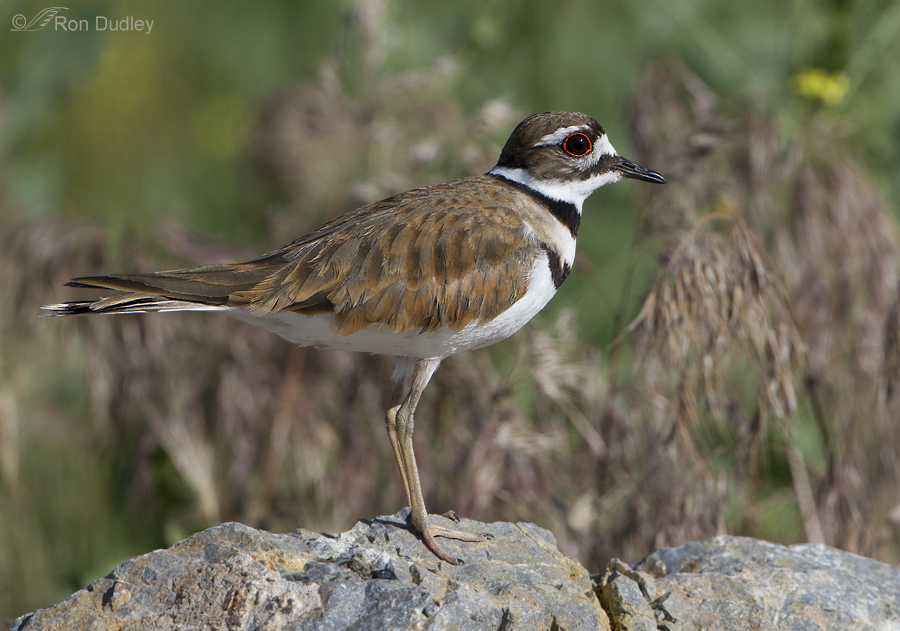
Another view of the “toe that isn’t there”.
I realize that this is probably elementary information for most folks who are well-schooled in birds but I remember when I finally realized that I’d never seen a Killdeer perched and eventually figured out why.
Perhaps there are others in the same boat as I was…
Ron


Wonderful! As in full of wonder! And should anyone attempt to rescue a raptor, and perchance get captured by the raptor instead as sometimes happens, remember that talon locking mechanism. Take a breath, stay calm, and straighten the leg before you try to peel the toes off one by one. Thank you again and again, Ron!
Interesting adaptations and photos. I first learned of this adaptation about a year ago when a friend in the telerobotics lab at the University of Utah mentioned it. They studied the perching adaptation of the passerines to developing a similar grasphing mechanical structure for their quad-copter unmanned aerial vehicles. This youtube video illustrates the structure well. http://www.youtube.com/watch?v=WdwxV2oQM_0 Of course, evolution over a geological time scale makes for a more compact and elegant design. Clearly, we’ve much to learn from observing the adaptations of plants and animals.
Wow, Craig – that video clip is simply wonderful for illustrating how the perching mechanism of a typical birds foot works. I hope everyone who reads this post watches the clip. Thanks so much!
It’s always great to know that your work can be useful to non-engineers – thanks for putting it out there Craig! For anyone who’s interested in seeing the mathematical approach to understanding this phenomena, feel free to brows my publications though I warn ahead of time, it can be a bit dry if math doesn’t excite you:
(list of papers) http://www.telerobotics.utah.edu/index.php/People/CourtneyDoyle
(additional videos) http://www.telerobotics.utah.edu/index.php/Research/Avian-InspiredGraspers
Ron, in follow-up to your response to M. Firpi below, the process is largely mechanical. The tendon is routed around a rounded cap at the ankle, so that when the leg bends, the feet are automatically pulled closed (because the distance the tendon must cover is increased, but the tendon does not stretch). In our mechanical adaptation seen in the video, the grasp is 100% passive. In birds, the tendon is attached to a muscle, so they also have the ability to open close the foot as needed for grasping in flight and adjusting balance on branches.
That’s an ingenious adaptation of the principal, Courtney. Loved the little “giggle of success” at the end of the last video.
I was aware of the mechanics in birds previously because I used to teach it in my zoology classes – even assigned my students to draw it.
Fabulous post, Ron. Thanks for sharing this info with us. I had wondered about how they hung on to the branch while asleep.
I have a request for a subject for us–that is, if you take requests and if you happen to be looking for a subject for us someday down the road. I would love to see a post on bill adaptations. I know it could be addressed simplistically–food collecting and mate attracting, but I would love to see one of your fabulously illustrated posts on the subject. (I hope I haven’t over stepped by making a request–if so please accept my apologies.)
I’ll put the subject on my list of potential posts and see what comes of it, Sharon. I do appreciate the suggestion and it does sound interesting.
This info is all new to me. I find it very interesting. Thank you for your great explanations as well your always wonderful images to illustrate your points. I also appreciate the fantastic images of the eagles you posted showing the differences in their looks at various stages in their life. What a terrific blog you have created!
Thanks very much for the nice words about my blog, Susan.
Ron, I didn’t know either. Thank you for that elementary lesson in avian foot morphology.
I’m glad you appreciated it.
This last year, I observed on two separate occasions, upland sandpipers, perched on telephone wires. They were not very stable, but I assume they must have some form of a back toe that helps them perch on the wires?
Rick, I’m unfamiliar with Upland Sandpipers but today I was researching plover feet and discovered that some of them do have what looks like a rudimentary 4th to pointing back. Or it may be, in the case of your sandpipers, that their front toes are just long enough to wrap around enough of the wire to give them a little stability. Just guessing…
Very informative! Thank you very much. I love the explanation with the pictures.
Thank you, Teri.
This is so beautifully written. That tendon-bone relationship in their feet for grasping must be linked to the proprioceptive sense by utilising the stretch receptors in the muscles to keep track of the joint position and body posture through the vestibular system. I was also reading it’s called the “sixth sense”, because it functions in an unconscious way. I had neurology classes that were so difficult, yet made sense when I had to deal with neurologically involved individuals. I also saw birds with neurological diseases when I went to a bird sanctuary. Thanks for teaching me all of this, as it applies to the birds. As always, your images are so detailed, I can feel this love for every detail of the birds.
Maria, It’s my understanding (I could be wrong) that the “tendon-bone relationship” that causes their feet to grasp when the leg is bent is a mechanical thing. When the leg is bent it stretches the tendon at the leg joint – that tendon goes down to the underside of the toes so when the tendon becomes more taught it closes the toes.
In humans it’s called “tenodesis”. When you said that birds fall asleep this way, I thought that it was owed more their unconscious vestibular/equilibrium system.
Pardon Ron, I meant “tenodesis grip” that is used by quadriplegics who must use the tenodesis grasp, which is mechanical in nature.
Ron, it’s not elementary to me and I’m glad you posted it. I never considered the Killdeer foot (sadly), but I will look more carefully now. In keeping with the theme, I actually have another rudimentary question. I’ve looked but haven’t found precisely what I’m looking for. Whenever I photograph cormorants roosting in trees, invariably, people passing by will ask how they perch with webbed feet. I explain that it’s actually a totipalmate foot. But after reading this post, I realized that I don’t fully know how a cormorant’s foot operates on the limb … what are the grasping mechanics of a totipalmate foot?
Ingrid, I’m not sure either. All I know is what I’ve observed. As you know, birds like pelicans and cormorants with totipalmate toes have all four of them connected by webbing. When I’ve seen cormorants perched on something like a small limb they usually seem to choose one small enoough that their toes can wrap around the front of it far enough to give them stability. That said, they seem like awkward perchers, often losing their balance if they move at all. Wish I knew more about it…
Thank you for cementing in my brain that which I have observed, but not yet assimilated. You should be a teacher! Ha Ha!
“Thank you for cementing in my brain that which I have observed, but not yet assimilated”.
I love the way you said that, Tana. That’s something most of us do often and it’s exactly what happened to me with the Killdeer not perching for all too long…
Thanks Ron! I did not know that about shorebirds.
I appreciate your comment, Angie.
My new knowledge for the day. Thank you for the information and beautiful photographs.
And than you for taking the time for your nice comment, Marvin.
Your blog is fantastic.
It should be assigned reading for High School Biology classes.
Your comment made my day, Bruce.
I agree, not just for the educational aspect but for the general appreciation and respect students would acquire about birds and other wildlife.
That is something I never knew, or actually never thought about. Thanks again, Ron, for another educational post. Great photos, too.
Thanks very much, Bob.
Great examples of this . As a bird painter I often do not give enough to the feet . I just haven’t looked at them well . Now with the help of your photos here I will always think of shore birds as possibly falling over backwards as they walk on the beach.
Have you seen and gotten a shot of the Killdeer ,or any shorebird ,faking injury to pull other prey away from nests. I have done paintings of this to get a point across about streesed out behavior . At this point the birds show personification. There is a lot of that in your photos . That is what I am after because the subject of the painting, birds ,takes on and ominous quality about the future of Humanity.
Check out Google image of Senegal Thick knee curlew in this fake injury position .
Keep up the great work ,try to stay warm out there.
I always enjoy your artistic response to my photos, Eldridge.
Yes, I have seen and photographed that behavior in Killdeer and in American Avocets. It’s often referred to as “the broken wing act”.
Not ‘elementary information’ for me, but then I’m trying to become more schooled on such information. Appreciate your posts/photos.
Thanks
GAP
Welcome, Gary. I appreciate your feedback.
This was helpful information for me since I am new to birding and have a lot to learn. Thank you for sharing your knowledge and your beautiful photographs. I enjoy reading your posts.
Great blog here Ron. I think I knew this once, but had not thought of it in a long time. Regardless, your usual awesome photos really explained this well.
Just a wonderful commentary, I never knew!
Thanks, Charlotte. I’m glad the commentary was useful to you.